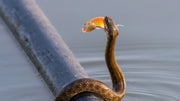
Few sights unsettle a pond-keeper more than a sinuous silhouette gliding across the waterline. Whether harmless water snake or venomous neighbor, a snake in the pond can spook family members and pose real danger to prized koi. The good news? You can discourage most reptiles without harming them—or disrupting the tranquil aesthetic you worked so hard to create. Below you’ll learn why snakes show up, tested tactics for how to keep snakes out of a pond, and design tweaks that protect fish while preserving the delicate balance of your backyard ecosystem.
Why Pond Owners Worry About Snakes
Snakes are opportunistic hunters. A healthy water garden provides everything they love: fresh drinking water, small amphibians, insect hatches, and slow-moving fish that hover near the surface. While many species simply pass through, others remain, stressing livestock and startling guests. For keepers of colorful, slow-bodied koi, the fear of predation is real—especially at dusk when visibility plummets. Combine that with the visceral discomfort some people feel around reptiles, and it’s clear why “pond snake” searches spike every summer.
Do Ponds Attract Snakes?

Not automatically—but certain conditions roll out a welcome mat:
- Abundant prey. Dense frog populations, goldfish fry, and insect larvae draw water snakes in ponds looking for an easy meal.
- Overhanging cover. Thick grass, ivy, or stacked wood piles adjacent to water let snakes approach unseen.
- Static shorelines. Calm, mirror-like pools make surface fish easier to spot and strike.
- Flat rocks for basking. Warm stones near the edge act like solar chargers, letting cold-blooded reptiles regain energy between feeds.
That’s why you’ll hear myths like “do koi ponds attract snakes?” The reply is: only if you build and maintain them in ways that favor reptile hunting grounds.
How to Keep Snakes Away from Your Pond

A. Trim and Tidy the Perimeter
Snakes hate exposure. Keep grass under four inches, prune shrubs so sunlight hits the soil, and relocate rock piles or firewood at least 20 feet away. A clean fringe forces would-be predators into the open, where they feel vulnerable to owls and hawks.
B. Use Surface Agitation
Snakes prefer placid shallows for stalking. Installing a Poposoap Floating Pond Fountain adds constant ripples and unpredictable spray, distorting a snake’s view of fish targets and making strikes far less accurate. Powered by the sun, it runs dawn to dusk without adding a penny to your utility bill.
C. Light Up the Waterline
Most reptiles hunt at low light. Ringing the pond with Poposoap RGB Multi-Color Solar Pond Lights bathes the edge in shifting hues whenever dusk falls. The gentle strobe effect deters nocturnal ambush while showcasing waterfalls and plants for evening entertaining.
D. Raise the Banks
Vertical edges deny snakes an easy slide into the water. If your pond was built with beach-style shelving, retrofit one or two walls with stacked flagstone rising at least 12 inches above the waterline. Cap with a broad coping stone so reptiles can’t coil around the edge.
E. Add Predatory Bird Perches
Snakes weigh risk against reward. Plant a stout post or place a decorative trellis near the pond to encourage kingfishers and herons—natural snake adversaries. Hanging a reflective spinner beneath amplifies motion and glare, which most serpents avoid.
F. Manage Fish Behavior
Feed koi or goldfish at set times from one location. Over time they’ll learn to school there and stay deeper elsewhere, reducing random surface cruising that advertises dinner.
G. Filter & Oxygenate
Rotting debris attracts frogs, which attract snakes. A Poposoap Solar Pond Filter strips organics and injects oxygen, discouraging insect swarms and amphibian booms that make your pond a buffet.
H. Skip Folk Remedies
Mothballs, sulfur, or gasoline do more harm to water quality than good for reptile deterrence. They also risk injuring birds and mammals. Stick with habitat modification—a proven, environmentally responsible route for how to keep snakes away from pond areas.
Are There Any Snake-Safe Pond Designs?

Absolutely. Consider these layout tweaks when planning or renovating:
- Depth over breadth. Deeper ponds (30–36″) let fish retreat below a snake’s diving capability, while surface footprints stay modest.
- Floating plant islands. Instead of marginal plants rooted at the shore, anchor water lettuce or hyacinth on floating foam rings. Fish hide below the dangling roots, forcing snakes to dive and struggle in mid-pool where you can see—and intercept—them.
- Integrated spillways. Poposoap Waterfall Kits create narrow, elevated chutes that deliver oxygen without forming still back-eddies—the favorite spot for ambush predators.
- Gravel beach at one end only. Provide shallow access for birds but surround remaining perimeter with stacked rock, denying serpents multiple entry points.
- Strategic lighting. Aim warm-white spotlights across the waterline rather than directly into it, leaving no shadows for a snake to linger undetected.
Designing defensively from day one cuts your need for later barriers or chemical deterrents.
What to Do If You See a Snake in Your Pond

- Stay calm and confirm species. Most North American pond snakes are non-venomous water snakes; their bite is startling but not life-threatening. If you’re unsure, keep distance and snap a zoomed photo for local wildlife officials.
- Remove temptation, not the snake. Use a skimmer net to clear surface frogs or fallen birdseed. Lift agitation (turn the fountain to high) so the serpent finds hunting inefficient.
- Provide an exit. A half-submerged branch angled to shore gives snakes a quick escape route. Many drowning incidents occur when reptiles can’t scale sheer liner walls.
- Avoid handling. Even a harmless snake will defend itself if grabbed. Let it leave under its own power once conditions become less attractive.
- Fortify afterward. Review the perimeter for new hiding spots, check that lights are charged, and ensure your Poposoap Floating Pond Fountain or AC Pond Pump is running at optimal flow.
Calling professional removal is rarely necessary unless you identify a dangerous venomous species—and even then, experts prefer relocation over eradication.
Conclusion: Snakes & Pond Balance
Snakes play an important ecological role by controlling rodents and disease-bearing amphibians. Your goal isn’t total exclusion—it’s tipping the odds so reptiles choose richer hunting grounds elsewhere while your fish thrive. Tidy banks, lively water movement, and thoughtful lighting create a pond that dazzles humans and frustrates serpents.
By pairing natural landscaping with solar-powered technology like Poposoap fountains, pond filters, and pond lights, you maintain healthy water dynamics without driving up energy bills or harming wildlife. Next time someone frets about pond snakes or asks how to keep snakes out of pond landscapes, you can share this balanced approach: reshape the habitat, light the margins, stir the surface—and let nature decide the rest.










